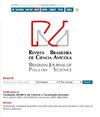Efficacy and Optimal Feeding Level of Rumex Nervosus Leaves on Blood Biochemistry, Carcass Characteristics, Productivity Indices, and Anticoccidial Indicators of Broiler Chickens Infected or Not Infected with Eimeria Tenella
IF 1.1
4区 农林科学
Q3 AGRICULTURE, DAIRY & ANIMAL SCIENCE
引用次数: 0
Abstract
The current study investigated the efficacy and optimal feeding level of Rumex nervosus leaves (RNL) in broilers infected and uninfected with Eimeria tenella . In a factorial design of 2 (coccidial challenge or not) 5 (feed treatments), 250-day-old broiler chicks were randomly assigned to one of ten groups and reared for 28 days. Intestinal measurements, carcass traits, serum biochemical indices, leukograms, performance and anticoccidial indicators were investigated. All selected parameters were not significantly ( p >0.05) altered by the interactions between the experimental diet and challenge at 7 days post-infection, with the exception of serum levels of albumin and globulin, as well as the anticoccidial index. Infected broilers had a lower performance indicator, poorer production efficiency, poor anticoccidial indices, heavier gizzard, longer and heavier small intestine, shorter cecum, and higher proportion of eosinophils compared with uninfected broilers. The RNL had marked anticoccidial efficacy at a dose of 5 g. The current study found that Rumex nervosus leaf powder had mild to marked, dose-dependent anticoccidial preventive efficacy in broilers. However, further studies are needed to fully understand the anticoccidial mechanisms.叶黄素对感染或未感染天牛艾美耳菌的肉鸡血液生化指标、胴体特征、生产指标和抗球虫指标的疗效及最佳饲喂量
本研究调查了瘤胃鲁梅克斯叶(RNL)对感染和未感染天牛艾美耳菌的肉鸡的疗效和最佳饲喂量。在2(球虫挑战或不挑战)5(饲料处理)的因子设计中,250日龄的肉用仔鸡被随机分配到10组中的一组,饲养28天。对肠道测量、胴体特征、血清生化指标、白细胞图谱、生产性能和抗球虫指标进行了调查。感染后 7 天,除血清白蛋白和球蛋白水平以及抗球虫指数外,所有选定参数均未因实验日粮和感染之间的相互作用而发生明显变化(p >0.05)。与未感染的肉鸡相比,感染肉鸡的生产性能指标较低、生产效率较差、抗球虫指数较低、胗较重、小肠较长且较重、盲肠较短、嗜酸性粒细胞比例较高。目前的研究发现,裸冠菊叶粉对肉鸡具有轻度到明显的、剂量依赖性的抗球虫预防效果。然而,要充分了解抗球虫机制还需要进一步的研究。
本文章由计算机程序翻译,如有差异,请以英文原文为准。
求助全文
约1分钟内获得全文
求助全文
来源期刊

Brazilian Journal of Poultry Science
农林科学-奶制品与动物科学
CiteScore
1.80
自引率
9.10%
发文量
60
审稿时长
>12 weeks
期刊介绍:
A Revista Brasileira de Ciência Avícola surgiu em 1999 a partir da necessidade que a comunidade científica possuía de um periódico para veiculação e publicação de seus trabalhos, com a publicação de três números anuais.
A Revista conta hoje com um corpo editorial altamente qualificado e com artigos científicos desenvolvidos pelos maiores especialistas da área, o que a cada dia atrai mais leitores em busca de inovação e respaldo técnico.
Devido à credibilidade que conquistou pelos esforços de sus autores, relatores e revisores, a Revista ganhou caráter de coleção, sendo consultada como fonte segura de estudo desenvolvidos na Avicultura.
A partir de 2003 – volume 5 -, a Revista passou a chamar-se Brazilian Journal of Poultry Science, e todos os trabalhos passaram a ser publicados em inglês. No mesmo ano subiu para quatro o número de revistas por volume, ampliando-se assim os trabalhos publicados anualmente.
 求助内容:
求助内容: 应助结果提醒方式:
应助结果提醒方式:


